Webb’s instruments: meet MIRI
Monday, 11 April 2022 06:00 Video:
00:01:00
Video:
00:01:00
The James Webb Space Telescope will explore the infrared Universe.
It will use four cutting-edge instruments, including the Mid-InfraRed Instrument. MIRI is one of Europe's contributions to the James Webb Space Telescope.
MIRI supports all of Webb’s science goals. It will image the Universe, study planets around our own and other stars and investigate stars and galaxies across cosmic history.
The instsrument will be kept extra cold by its very own ‘cryocooler’. This stops heat from Webb disrupting MIRI’s detectors, so the sensitive instrument can see mid-infrared light.
Webb is an international partnership between NASA, ESA and CSA
Learn more
House committee leaders ask White House to withdraw proposed NTSB regulations on commercial launch investigations
Sunday, 10 April 2022 19:12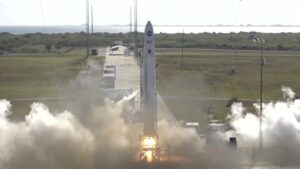
The leaders of the House Science Committee have asked the Biden administration to withdraw a controversial proposed rule regarding commercial spaceflight investigations, calling it “plainly unlawful.”
The post House committee leaders ask White House to withdraw proposed NTSB regulations on commercial launch investigations appeared first on SpaceNews.
Kendall highlights space's importance, need to 'transform' operations and thinking for the domain
Sunday, 10 April 2022 10:39 Presenting a robust case for operating in - and defending - space, Air Force Secretary Frank Kendall said April 5 that "transforming" without delay priorities, practices and spending for the domain is necessary to adequately adapt to a theater that is more volatile yet also increasingly essential to the nation's security and everyday life.
"Space is a warfighting domain now," Kendall blunt
Presenting a robust case for operating in - and defending - space, Air Force Secretary Frank Kendall said April 5 that "transforming" without delay priorities, practices and spending for the domain is necessary to adequately adapt to a theater that is more volatile yet also increasingly essential to the nation's security and everyday life.
"Space is a warfighting domain now," Kendall blunt Raymond praises Space Force achievements and purpose while noting ongoing threats, challenges
Sunday, 10 April 2022 10:39 Using language that was both stark and an urgent call to action, Chief of Space Operations, Gen. John W. "Jay" Raymond, said April 5 that the cornerstone to U.S. security and prosperity is keeping space "accessible, stable, and secure."
And while achieving that goal was once a foregone conclusion, it no longer is. That is why the U.S., its allies and most of all, the United States Space Fo
Using language that was both stark and an urgent call to action, Chief of Space Operations, Gen. John W. "Jay" Raymond, said April 5 that the cornerstone to U.S. security and prosperity is keeping space "accessible, stable, and secure."
And while achieving that goal was once a foregone conclusion, it no longer is. That is why the U.S., its allies and most of all, the United States Space Fo Astronomers detect galactic space laser
Sunday, 10 April 2022 10:39 A powerful radio-wave laser, called a 'megamaser', has been observed by the MeerKAT telescope in South Africa.
The record-breaking find is the most distant megamaser of its kind ever detected, at about five billion light years from Earth.
The light from the megamaser has travelled 58 thousand billion billion (58 followed by 21 zeros) kilometres to Earth.
The discovery was made
A powerful radio-wave laser, called a 'megamaser', has been observed by the MeerKAT telescope in South Africa.
The record-breaking find is the most distant megamaser of its kind ever detected, at about five billion light years from Earth.
The light from the megamaser has travelled 58 thousand billion billion (58 followed by 21 zeros) kilometres to Earth.
The discovery was made CACI completes review for planned 2023 satellite launch
Sunday, 10 April 2022 10:39 CACI International Inc (NYSE: CACI) has completed the Critical Design Review (CDR) for its demonstration small satellite program (DemoSat) launch scheduled for early 2023, which is slated to deliver two mission payloads to low earth orbit. CACI and its partner, York Space Systems - a specialized manufacturer of spacecraft and space collection solutions - will demonstrate alternative positioning,
CACI International Inc (NYSE: CACI) has completed the Critical Design Review (CDR) for its demonstration small satellite program (DemoSat) launch scheduled for early 2023, which is slated to deliver two mission payloads to low earth orbit. CACI and its partner, York Space Systems - a specialized manufacturer of spacecraft and space collection solutions - will demonstrate alternative positioning, The hunt for the gravitational wave background
Sunday, 10 April 2022 10:39 Coalescing supermassive black holes in the centers of merging galaxies fill the universe with low-frequency gravitational waves. Astronomers have been searching for these waves by using large radio telescopes to look for the subtle effect these spacetime ripples have on radio waves emitted by pulsars within our Galaxy.
Now, an international team of scientists has shown that the high-energy
Coalescing supermassive black holes in the centers of merging galaxies fill the universe with low-frequency gravitational waves. Astronomers have been searching for these waves by using large radio telescopes to look for the subtle effect these spacetime ripples have on radio waves emitted by pulsars within our Galaxy.
Now, an international team of scientists has shown that the high-energy Space Development Agency to accelerate deployment of missile-tracking satellites
Sunday, 10 April 2022 10:06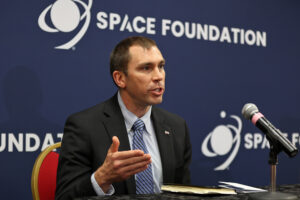
The U.S. Space Force is requesting an additional $200 million in fiscal year 2023 to launch satellites for the Space Development Agency’s missile-tracking constellation.
The post Space Development Agency to accelerate deployment of missile-tracking satellites appeared first on SpaceNews.
First all-private mission docks with ISS
Sunday, 10 April 2022 02:26 The crew from the first all-private mission to the International Space Station docked with the orbital outpost Saturday morning, a historic moment marked by a ceremonial welcome from astronauts on board.
SpaceX's Crew Dragon Endeavor docked at the ISS at 8:29 a.m. EDT and astronauts entered the orbital outpost at 10:13 a.m.
The docking process was held up for about 45 minutes aft
The crew from the first all-private mission to the International Space Station docked with the orbital outpost Saturday morning, a historic moment marked by a ceremonial welcome from astronauts on board.
SpaceX's Crew Dragon Endeavor docked at the ISS at 8:29 a.m. EDT and astronauts entered the orbital outpost at 10:13 a.m.
The docking process was held up for about 45 minutes aft NASA to delay, modify SLS countdown rehearsal
Saturday, 09 April 2022 22:44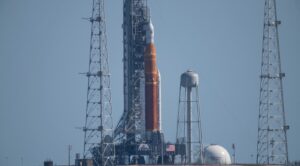
After discovering a problem with a valve on the Space Launch System’s upper stage, NASA is delaying a countdown rehearsal and fueling test and modifying it to limit fueling of the upper stage.
First private mission reaches International Space Station
Saturday, 09 April 2022 19:36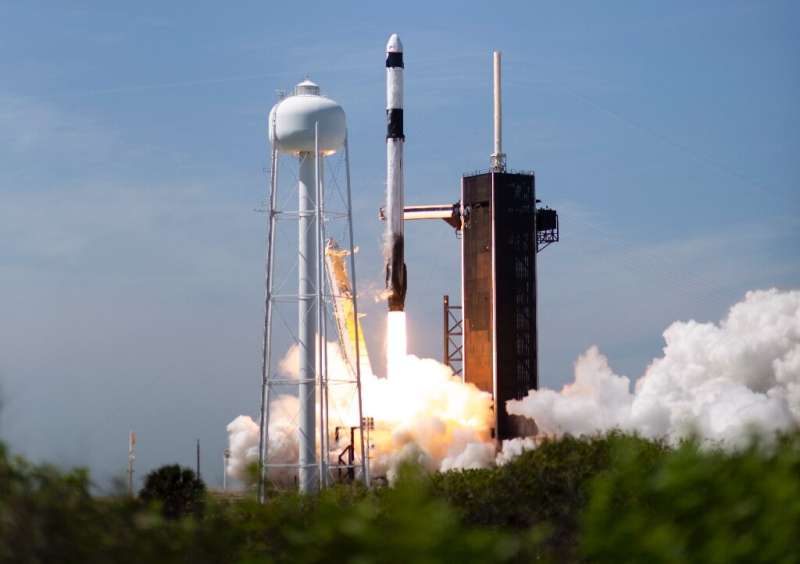
The first fully private mission reached the International Space Station early Saturday with a four-member crew from startup company Axiom Space.
NASA has hailed the three-way partnership with Axiom and SpaceX as a key step towards commercializing the region of space known as "Low Earth Orbit," leaving the agency to focus on more ambitious voyages deeper into the cosmos.
A SpaceX Falcon 9 rocket with the Crew Dragon capsule Endeavor docked at 1229 GMT Saturday and the crew entered the space station nearly two hours later, after launching from the Kennedy Space Center in Florida on Friday.
Air Force Research Lab experiment to assess benefits of multi-orbit satellite navigation
Saturday, 09 April 2022 17:41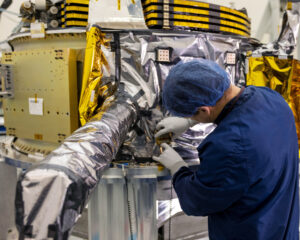
The Navigation Technology Satellite-3 (NTS-3), an experiment funded by the Air Force Research Laboratory, will broadcast PNT signals from geostationary orbit to supplement GPS satellites in medium Earth orbit
The post Air Force Research Lab experiment to assess benefits of multi-orbit satellite navigation appeared first on SpaceNews.
Air Force space experiment will seek to demonstrate multi-orbit satellite navigation
Saturday, 09 April 2022 17:41
The Navigation Technology Satellite-3 (NTS-3), an experiment funded by the Air Force Research Laboratory, will broadcast PNT signals from geostationary orbit to supplement GPS satellites in medium Earth orbit
The post Air Force space experiment will seek to demonstrate multi-orbit satellite navigation appeared first on SpaceNews.
Japanese satellite laser-comm startup Warpspace draws bead on U.S. market
Saturday, 09 April 2022 15:15
Warpspace, a Japanese space startup developing an inter-satellite laser communications system, is establishing a U.S. presence to partner with American companies and compete for government and military contracts.
The post Japanese satellite laser-comm startup Warpspace draws bead on U.S.
Axiom mission arrives at ISS
Saturday, 09 April 2022 14:49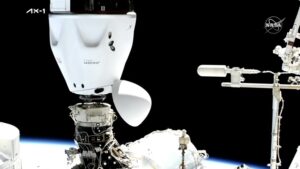
A SpaceX Crew Dragon spacecraft carrying four private astronauts arrived at the International Space Station April 9 for a scheduled eight-day stay.
The post Axiom mission arrives at ISS appeared first on SpaceNews.

